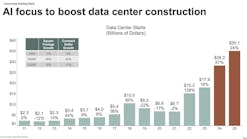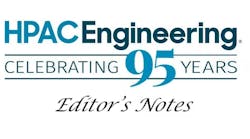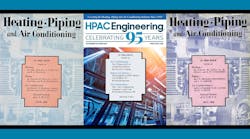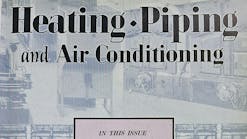In many ways, normalcy made a strong comeback in 2022.
To be sure, the broad societal and economic anxiety and uncertainty of the COVID Era have not completely disappeared. But hope is growing that 2023 will ultimately put the pandemic in the rearview mirror.
At the same time, however, the ever-present fear of the inevitable U.S. recession continues to gnaw at our collective confidence, even though many now believe that its actual arrival may be delayed another year.
With all that in mind, we present here several industry viewpoints about some of the issues and innovations expected to drive change in our industry this year. From increased federal stimulus funding and incentivized national competitions to regulatory changes, advancing technologies and global decarbonization pressures, a host factors will mix this year with continuing concerns over inflation, supply chain delays and workforce shortages. Here are 10 takes on what's ahead...
##########
David Budzinski, VP and general manager, Residential and Light Commercial, Johnson Controls
After years of preparation, 2023 marks the launch of increased Department of Energy (DOE) standards for both residential and light commercial applications. It’s critical that contractors understand which region they’re located in – as specified by the DOE – and the types of products they can install based on the region’s efficiency requirements. Regionality will also determine whether product compliance is based on date of installation or date of manufacture.
Heat-pumps are positioned to make a significant impact as decarbonization efforts advance. For example, the Johnson Controls commercial building Energy Efficiency Indicator Survey for 2021 revealed that more than a third of respondents had planned to replace fossil fuel heating equipment with heat pump technology by the end of 2022, which was a 7% increase from the previous year. Hydronic heat pumps are an energy-efficient alternative that can replace boilers to help reduce carbon emissions.
Within the residential market, the DOE Cold Climate Heat Pump Technology Challenge has inspired partnering manufacturers to develop technologies that can accommodate increased heating loads within colder climates. Advanced residential systems can achieve up to a 2.0 coefficient of performance (COP) or better, and maintain 50-80% heating capacity in outdoor temperatures as low as 5 degrees now, making heat pumps a viable option for many homeowners.
However, it's important to note that many air-source heat pump systems still need to include some form of backup or supplemental heat when building heating demands exceed capacity (when ambient outdoor temperatures drop too low to support optimal operation, for example). Supplemental gas heating may still be necessary to help maintain efficiency.
##########
Justin Keppy, President, NA Residential & Light Commercial HVAC, Carrier
Carrier is ready for phase two of the Cold Climate Heat Pump Challenge, which is field testing its prototype heat pump in a harsh climate. This milestone comes on the heels of the Inflation Reduction Act, which provides $370 billion for clean energy investments in the form of tax credits, incentives and rebates to improve energy efficiency.
The DOE’s challenge aims to accelerate commercialization of heat pumps that meet comfort needs in cold climate regions of North America – thereby expanding energy-efficient and incentive-eligible heating and cooling options for consumers.
"We’re pleased with the lab performance of our prototype heat pump and the final test results," says Keppy. "Our team of dedicated engineers and product managers are hard at work continuing to develop next generation heat pumps to increase efficiency, save consumers money and benefit the environment. The federal incentives offered through the IRA are critical to the adoption of high-efficiency heat pumps, and Carrier is committed to delivering innovative climate-friendly technologies."
To participate in the challenge, Carrier committed to producing a heat pump with increased cold climate performance, increased heating capacity at lower ambient temperatures, higher efficiency across a range of climate conditions, and advanced controls to adjust usage on demand.
"Heat pumps continue to rise in popularity as a result of decarbonization efforts of states such as California, Washington and New York and incentives by local rebate programs," adds Keppy. "Additionally, the launch of Carrier’s EcoHome™ program will make the transition from low-efficiency units to high-efficiency heat pumps cost-effective. Advancements in heat pump technologies are critical to supporting these initiatives and driving adoption."
##########
Miranda Berner, Director of Marketing, Berner Air Curtains
The green movement continues and Environmental, Social and Governance (ESG) goals are increasingly common for companies large and small, which means an even bigger commitment to sustainability by the marketplace.
An air curtain is one HVAC product that empowers engineers, facility owners and contractors to improve energy efficiency, indoor air quality, building decarbonization, and occupant comfort.
The technology trend continues for manufacturers to develop digital controls, internet operability with apps, and compatibility with building management systems through protocols like BACnet for their equipment.
Attracting and retaining talent, continues to be a challenge and opportunity for the industry.
There are a lot of bright people looking for work to be meaningful, not just a paycheck, and the cool thing about working in this industry, at any level, is that HVAC done well directly improves people’s air comfort and health, as well as saves the planet. Energy conservation means greenhouse gas (GHG) reduction and building decarbonization.
##########
Mark Bublitz, 2022-23 President, Air Movement and Control Association International (AMCA)
Not to be overdramatic, but recent regulatory efforts are the most significant events impacting the U.S. market for commercial and industrial fans and blowers in the history of the industry. In 2022, the California Energy Commission approved an efficiency regulation and the U.S. DOE published a draft test procedure for commercial and industrial fans and blowers.
Regulation of an industry for the first time is tremendously stressful and burdensome for manufacturers, especially small and medium-sized ones, the kind that comprise the majority of AMCA’s membership. Classifying products into regulatory product classes, inventorying historical performance data of covered products, determining and administering supplemental testing, and certifying compliance into regulatory databases requires a massive commitment of staff time and information technology investment. Additionally, there are requirements to educate distributors and customers and update software and literature.
What’s more, the industry has to adapt to maintain the ability to serve customers’ needs with often unique solutions. We do not want to see solutions that have performed well and met customers’ needs for years be miscategorized and removed from the market, and we have to continue to develop new products to meet our customers’ evolving needs.
It’s possible purchasers of fans and blowers will see traditional offerings become unavailable, and there will be differences in how sizing/selection software operates. This could be the result of certain products being removed from the market, as we’ve seen in Europe, or, for certain areas of the operating range of a fan, becoming non-selectable, for lack of a better term.
##########
Andres Caballero, President, Uponor North America
At Uponor, we enter 2023 with cautious optimism.
Residential construction is (likely) going to be slow to recover, but commercial construction is showing some positive signs. Where we see the greatest potential is in the remodel, service, and retrofit markets. How these three areas factor into a recession is indeterminate, however we are taking steps to position ourselves with the right people, products, and solutions in place to respond as the markets shift.
The housing market is in a strange place, with many builders reporting huge backlogs, while at the same time seeing a decline in new housing starts. But we see tremendous opportunities in multifamily, hospitality, and other commercial sectors. We are focused on growing our core businesses, while introducing innovative new products and solutions — such as Smatrix Pulse, TotalFit™, AquaPort™, and Uponor Kitting Services — that will allow contractors to integrate productivity and high-performing systems into their projects.
Of course, we continue to expect pressure from high inflation, supply chain constrains, and some specialty raw materials. Our priority is to continue to provide the highest quality product for water solutions that customers in North America and around the world come to expect from Uponor.
We will look into market dynamics proactively as we consider possible price actions while ensuring customers get the most value from our products and solutions.
##########
Dan Jones, President, UV Resources
Commercial building engineers and facility managers are upgrading HVAC filter efficiency following public health and building scientists' (including the White House) clean and healthy air recommendations.
However, not all air handlers or packaged rooftop HVAC systems – particularly the large number of aging systems – can handle the high airflow restrictions or increased static pressure of MERV 13 or higher efficiency filters. Schools, especially, looking to leverage federal funding, are struggling to overcome this physical reality.
Adding a high-efficiency HVAC filter can reduce airflow—essentially starving the machine of air. Moreover, limiting airflow inhibits heat transfer, forcing HVAC engineers to compensate by increasing fan speed or lowering chilled water temperatures where possible, which raises energy consumption.
Independent, third-party testing found that facility engineers can exceed a MERV 13 filter's pathogen removal performance by combining UV-C disinfection with medium-efficiency (MERV 8) filters.
We think this layering of air cleaning technologies will enable thousands of building managers to meet or exceed federal indoor air quality recommendations without limiting airflow and obstructing HVAC system operation.
Just as no one would operate an HVAC system without air filters—the time is near when no one will operate HVAC/R systems without UV-C installed.
##########
Aaron Engel,VP of New Business Development, Fresh-Aire UV
Returning to the fundamentals of indoor air quality is the key trend in HVAC today.
The industry has been so focused on disinfecting air and surfaces since the pandemic began 2020 that it has lost sight of IAQ fundamentals, such as maintaining clean and healthy HVAC systems, increasing energy efficiency and reducing odors.
When studies emerged later in 2020 that 254-nanometer UV-C light disinfection neutralized SARS-CoV-2, the virus that causes COVID-19, indoor air treatment efforts focused mostly on microbes.
Now that the pandemic is waning, we’re seeing trends that embrace UV-C’s original benefits of increasing HVAC coil and equipment performance and the resulting improvement in energy efficiency while reducing maintenance costs. Basically, contractors, consulting engineers and facility owners want to ensure HVAC systems aren’t contributing to poor IAQ while maintaining peak equipment operating conditions.
Maintaining HVAC coils and AHUs free of mold, biofilm and particulates is best practices in an age where we have increased rates of asthma and other respiratory conditions. This trend also aims to prolong the useful life of residential and commercial HVAC coils by keeping them free of pressure-robbing mold and biofilm.
Ensuring the best heat transfer and system static pressure will benefit the bottom line of homeowners and facility owners not to mention improved IAQ.
#######
Christian Geisthoff, VP of Corporate Development, Viega LLC
Viega expects the multi-family housing, commercial, and industrial markets to remain healthy into 2023.
The biggest challenges for 2023 will be the continued tight labor market, inflation, and supply chain issues, which will have the biggest impact on completing projects on time. While the Inflation Reduction Act will offer opportunities for the industry, the concern or caveat would be whether or not we can get enough of the products needed for certain projects, to support hydrogen over natural gas, for instance.
We also expect to see more use of artiificial intelligence (AI) and augmented reality (AR) influencing in the industry.
Automation of the installation process can also provide better control tools over the production side and how we manage between the different trades. There’s also an emphasis on increased use of smart technology (particularly for monitoring) to identify problems before they become catastrophic.
Viega is generally optimistic heading into 2023 and, although we expect there to be some volatility ahead, when you look at the overall picture holistically, it’s still positive.
##########
Laurie Conner, President, The Detection Group, a WATTS brand
With pipe infrastructure repairs now a funding priority nationwide, leak monitoring and detection systems have come of age. Today, water leaks within a building are a risk to any facility, 24-7-365. One trillion gallons of water is lost to leaks each year nationwide, causing $10-15 billion in insurance claims.
Domestic water plumbing, HVAC or process liquid leaks occur daily in a broad range of facilities nationwide. Without some means of early detection, by the time a leak is discovered, it’s often too late. There are risks to tenants, building infrastructure and data systems. Yet, the downstream threat of mold growth can be of greater concern. Sources of leaks may be a burst water pipe, water-supplied appliance malfunction, corroded or frozen sprinkler systems, clogged drains, or leaking plumbing fixtures.
The best way to reduce potential damage is technology that detects and stops uncontrolled water flow, including water sensors, real-time notification systems, and automatic shut-off valves. System components now can be installed in hard-to-reach places to provide consistent, round-the-clock monitoring and notification of precise leak location.
Building managers, now more than ever, are turning to sensors and cloud systems for remote, actionable information. And modern technology can watch hundreds of locations within a single building or many buildings, and provide facility managers with the peace of mind that their buildings are protected.
##########
Clark Zacaroli, VP Sales and Marketing, Runtal North America Inc.
Low-temperature heating systems have become widely accepted as state-of-the-art for a wide range of applications. Expect this trend to continue and to grow
The Europeans had it nailed decades ago, but it took some time and convincing for Americans to recognize the value of kinder/gentler warmth that dialed-in radiant systems provide – with delivery temps of 85 to 110°F for floors, and 100-120°F for panels.
Advantages to low-temp radiant heat abound. Plenty of HVAC tests have found that the greatest levels of human comfort stem from cooler supply temperatures. The other advantage to this is that fuel/energy is saved.
Industry experts have learned that the greater the area for distribution of heat (such as in-floor or in-wall systems), the lower the distribution temps can be to provide optimal comfort. But if floors or walls can’t be used, the next best type of heat distribution are panel radiators.
With wall-mounted panel radiators, the primary heat transfer to the space is radiant vs. convective, so effective comfort levels are achieved at lower temperatures with a slight increase in the size of the panel radiator. It helps, of course, if all distribution piping is insulated.
If outdoor reset is coupled with indoor temperature feedback, comfort and efficiency are assured. If the building envelop is tight, indoor temperature feedback dials-in lower-temp distribution, as opposed to outdoor reset alone.
##########



















